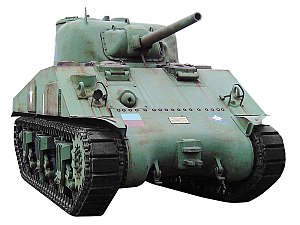Lend-Lease Sherman tanks
| Medium Tank M4A2 Sherman III | |
|---|---|

Medium Tank M4A2 Sherman III. Most of these, the only large-production diesel variant, were Lend-Leased to the Allies
|
|
| Place of origin | United States |
| Specifications | |
| Weight | 29.94 tonnes (66,000 lbs empty (late production)) |
| Length | 5.92 m (19.42 ft) |
| Width | 2.62 m (8.6 ft) |
| Height | 2.74 m (8.99 ft) |
| Crew | 5 |
|
|
|
| Armor | 13 - 108 mm (0.5 - 4.25 in) (late production) |
|
Main
armament |
75 mm M3 L/40 Gun 97 rounds |
|
Secondary
armament |
.50 Browning M2HB machinegun 300 rounds 2× .30-06 Browning M1919A4 machineguns 4,750 rounds |
| Engine |
General Motors 6046 diesel (conjoined twin 6-71s) 410 hp gross @ 2900 rpm 375 hp net (280 kW) @ 2100 rpm |
| Power/weight | 12.89 hp/tonne |
| Suspension | Vertical Volute Spring Suspension (VVSS) |
| Speed | 48 km/h (30 mi/h) brief level |
The United States provided tens of thousands of its Medium Tank M4, also named the Sherman, to many of its Allies during the Second World War, under the terms of Lend-Lease.
The British received far more M4 medium tanks, approximately 17,000 (roughly 34% of all M4s produced), than any other Allied nation. The British practice of naming American tanks after American Civil War generals was continued, giving it the name General Sherman after Union General William Tecumseh Sherman, usually shortened to Sherman. The US later adopted the name and the practice of naming tanks after generals.
In the British naming system, the major variants were identified by Mark numbers, the M4 being "Sherman I", the M4A1 "Sherman II" and so on. Letters after the mark number denoted modifications to the base model: "A" for the 76 mm L/55 gun instead of the 75mm, "B" for the 105 mm M4 L/22.5 howitzer, "C" for the (British) QF 17 pounder (76.2 mm) gun, and "Y" for the later wider-tracked Horizontal Volute Spring Suspension (HVSS) type suspension. Gun and suspension letters were used in combination, e.g. Sherman IBY. However, no production 75mm Shermans were built with HVSS and no HVSS Firefly conversions (CY) therefore existed. HVSS Shermans were only fitted with 76mm M1 guns or 105mm M4 howitzers, AY and BY respectively in British service.
Conversions and modifications of the M4 by their foreign users included the British-Commonwealth Firefly with the potent British QF 17 pounder (76.2 mm) anti-tank gun; Adder, Salamander, Crocodile, and Badgerflame-throwing Shermans; Kangaroo armoured personnel carrier; Armoured recovery vehicles (ARV); artillery tractors, and the specialist military engineering vehicles of "Hobart's Funnies" designed specifically for Operation Overlord ("D-Day") and the Battle of Normandy. In 1945, the 1st Coldstream Guards at the Rhine fitted Sherman turrets with two "60 lb" RP-3 air-to-ground rockets on rails to create the Sherman Tulip. Canada created a prototype anti-aircraft vehicle with four 20 mm Polsten cannons mounted in a turret on Canadian-made M4A1 hull, which was called Skink. The Soviets reportedly replaced the US 75 mm gun on some M4A2s with the 76.2mm F-34 gun of the T-34 medium tank to create the M4M; they discontinued the practice when assured of US ammunition supply (Zaloga 1984:217). For the D-Day landings, the British developed special and specific deep wading kits for Shermans I/II, III and V. US forces in the Pacific suffered many drowned M4s by not having such kits early in the island landing campaigns, and they were rapidly copied for later landings.
...
Wikipedia
